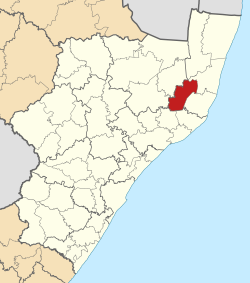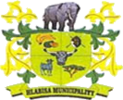Hlabisa | |
|---|---|
 Location in KwaZulu-Natal | |
| Country | South Africa |
| Province | KwaZulu-Natal |
| District | uMkhanyakude |
| Seat | Hlabisa |
| Wards | 8 |
| Government | |
| • Type | Municipal council |
| • Mayor | Bhekinkosi Ntombela |
| Area | |
| • Total | 1,555 km2 (600 sq mi) |
| Population (2011)[2] | |
| • Total | 71,925 |
| • Density | 46/km2 (120/sq mi) |
| Racial makeup (2011) | |
| • Black African | 99.4% |
| • Coloured | 0.1% |
| • Indian/Asian | 0.2% |
| • White | 0.1% |
| First languages (2011) | |
| • Zulu | 95.0% |
| • Southern Ndebele | 1.5% |
| • English | 1.2% |
| • Other | 2.3% |
| Time zone | UTC+2 (SAST) |
| Municipal code | KZN274 |
Hlabisa was an administrative area in the Umkhanyakude District of KwaZulu-Natal in South Africa. Hlabisa is an isiZulu surname of the two nkosis (kings) in the area. The municipality was situated within the vicinity of four Tribal Authorities which are the Mkhwanazi Tribal Authority, the Mdletshe Tribal Authority, and two Hlabisa Tribal Authorities.[3]
The municipality was generally characterised by isolated rural communities with high levels of poverty. The most significant land use was subsistence agriculture and dispersed settlements, plantations and agriculture are found throughout the municipality. The major draw card of Hlabisa was the tourism industry centred on the adjacent game reserve.[4]
After municipal elections on 3 August 2016 it was merged into the larger Big Five Hlabisa Local Municipality.
- ^ "Contact list: Executive Mayors". Government Communication & Information System. Archived from the original on 14 July 2010. Retrieved 22 February 2012.
- ^ a b c "Statistics by place". Statistics South Africa. Retrieved 27 September 2015.
- ^ South African Languages - Place names
- ^ "KwaZulu-Natal Top Business - Hlabisa Municipality". Archived from the original on 2011-08-19. Retrieved 2010-12-29.
